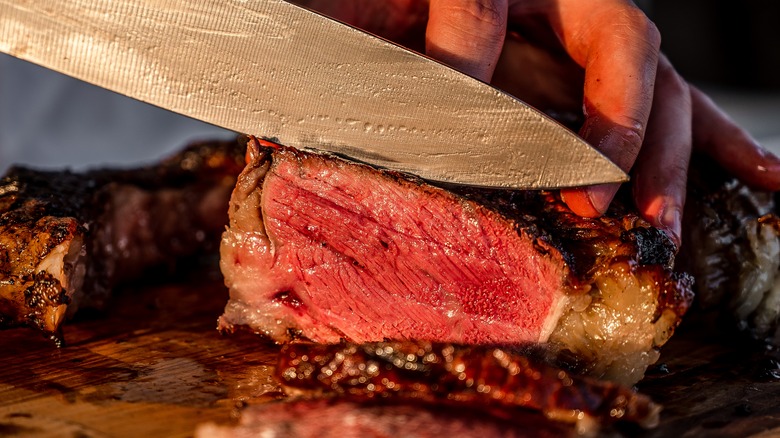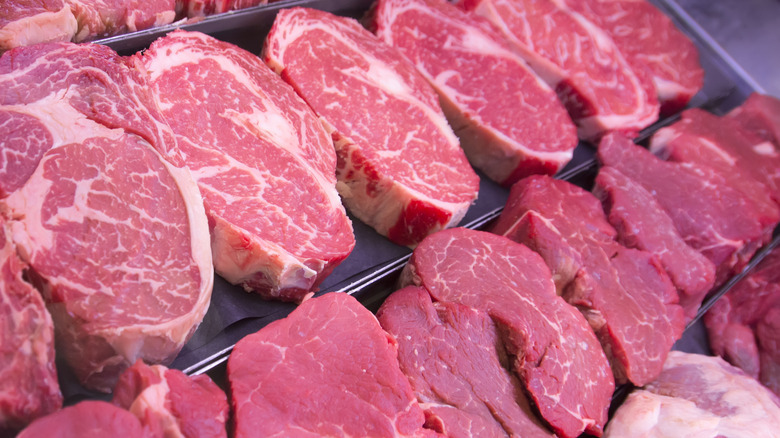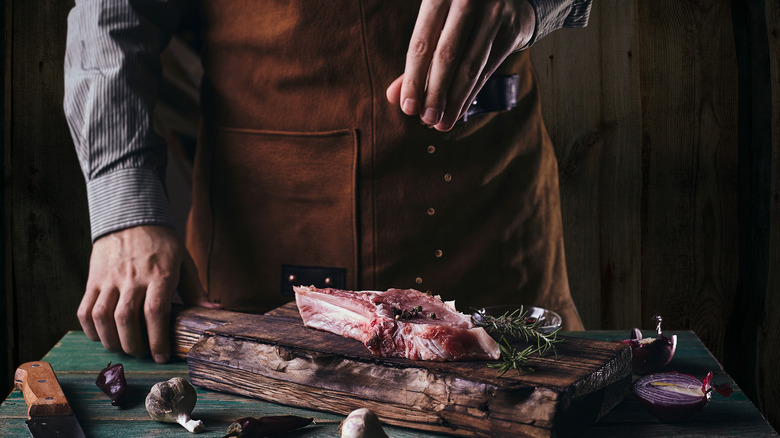What's The Difference Between Ribeye And Sirloin?
Few foods intrigue the primal human palate like steak — a very specific term that has all but come to mean one thing. Merriam-Webster defines the word as a fleshy slice of meat which could likewise include fish or non-animal foods like cauliflower, portobello mushrooms, lentils, or tofu. A steak can also suggest a steak in form and function, like hamburger steak. The point here is that a steak should be a thick, juicy, satisfying slice of something, and that something is typically beef. According to Statista, the U.S. leads the world in beef production, contributing around 12.6 million tons of beef and veal in 2021 alone (per net carcass weight).
Statista adds that the States' meat profits mainly come from fresh beef, with Americans spending about nine dollars on beef every time they went to the supermarket in 2020, and that's enough to buy around two pounds of ground beef or one pound of sirloin steak during each outing. L'academie reports that there are plenty of beef steak varieties to appeal to the modern foodies' taste and textural preferences, naming 18 popular types. Whether you seek steak for a date night dinner or your weekly meal rotation, you should know about two of the most common and beloved steak options out there: ribeye and sirloin.
What's at steak here?
According to Beef. It's What's For Dinner, ribeye steaks are part of the rib primal (or group of cuts) — located under the front area of the spine, which carries a lot of the animal's weight. However, L'academie explains that beef cattle's back muscle doesn't see much movement, which helps contribute to the ribeye's renowned tenderness. MasterClass adds that the ribeyes are normally taken from the 9th-11th ribs and include the "eye" muscle (also found in strip steak) and the rib cap or deckle, which has signature swirls ("marbling") of intramuscular fat, further contributing to the flavor and juiciness of this famous steak. MasterClass further explains that ribeye is well-suited for a quick, hot cook and that it must be carefully prepared to make the most of this choice cut — while L'academie notes that its fat content does help keep it moist.
Sirloin steak is from the subprimal posterior near the short loin (per L'academie) which translates to the lower back past the sixth and final lumbar backbones and the hip bone (per MasterClass). Though MasterClass explains that sirloin is not as tender as strip steak and T-bone steaks, sirloin is leaner and usually more affordable — and with the proper TLC like marinating and diligent cooking, it is a versatile and flavorful cut. MasterClass writes that sirloin steak's rough texture is more suitable for marinating than the tender, marbled cuts but they must be cooked quickly and sliced against the grain for the best eating.
How to cook ribeye and sirloin steak
Steak purists will tell you that a steak needs little more than conscientious cooking to provide a memorable eating experience. Refer to a doneness chart from Certified Angus Beef for specific temperatures, and know that the longer you cook a steak, the less juicy it will turn out to be. You can cook steak in a cast iron skillet or a frying pan, on the grill, sous vide, or even the oven. Classic pairings include butter, herbs, potatoes, horseradish, blue cheese, and mushrooms. Butcher shops and supermarket meat counters may have the freshest beef selection. Choose steaks that are red to reddish-purple, relatively dry and firm, have a clean meaty smell, and intact packaging with a sell-by date that has not passed, according to Food Network. There are also local options from farms and farmer's markets — often grass-fed. While Healthline tells us that grass-fed beef may be a better bet than conventionally raised, grain-fed beef due to its lower fat and higher amounts of protein, antioxidants, fatty acids, and vitamin E, many eaters prefer the milder taste of conventional beef, especially in a fatty cut like ribeye.
Mouthwatering and Insta-ready ribeye is the favorite of chefs like Gordon Ramsay and Bobby Flay. Try ribeye with hot peppers and citrus to compliment its buttery fattiness. If you want to showcase this steak's characteristics in a less "fancy" setting, know that authentic philly cheesesteaks call for ribeye, even though they also call for it doused in Cheese Wiz. Leaner, budget-friendly sirloin steak loves to be grilled, stir fried, or simply seared, as in BBC Good Food's steak with chimichurri sauce. MasterClass writes that sirloin is also commonly used for ground beef and kebabs. Pair it with vegetables for an easy, impressive, and healthy meal: Healthline reports that beef is rich in protein, amino acids, vitamin B12, zinc, and other minerals and nutrients. Regardless of how you choose to enjoy your next steak, just be sure to cook it with care to do justice to this simple and satisfying protein.


